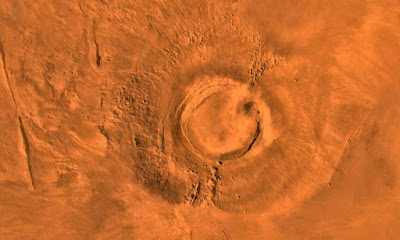New NASA research reveals that the giant Martian shield volcano Arsia Mons produced one new lava flow at its summit every 1 to 3 million years during the final peak of activity. The last volcanic activity there ceased about 50 million years ago—around the time of Earth's Cretaceous-Paleogene extinction, when large numbers of our planet's plant and animal species (including dinosaurs) went extinct.
Located just south of Mars' equator, Arsia Mons is the southernmost member of a trio of broad, gently sloping shield volcanoes collectively known as Tharsis Montes. Arsia Mons was built up over billions of years, though the details of its lifecycle are still being worked out. The most recent volcanic activity is thought to have taken place in the caldera—the bowl-shaped depression at the top—where 29 volcanic vents have been identified. Until now, it's been difficult to make a precise estimate of when this volcanic field was active.
"We estimate that the peak activity for the volcanic field at the summit of Arsia Mons probably occurred approximately 150 million years ago—the late Jurassic period on Earth—and then died out around the same time as Earth's dinosaurs," said Jacob Richardson, a postdoctoral researcher at NASA's Goddard Space Flight Center in Greenbelt, Maryland. "It's possible, though, that the last volcanic vent or two might have been active in the past 50 million years, which is very recent in geological terms."
Richardson is presenting the findings on March 20, 2017, at the Lunar and Planetary Science Conference in The Woodlands, Texas. The study also is published in Earth and Planetary Science Letters.
Phys.org: Mars volcano, Earth's dinosaurs went extinct about the same timeElizabeth Zubritsky

Comments